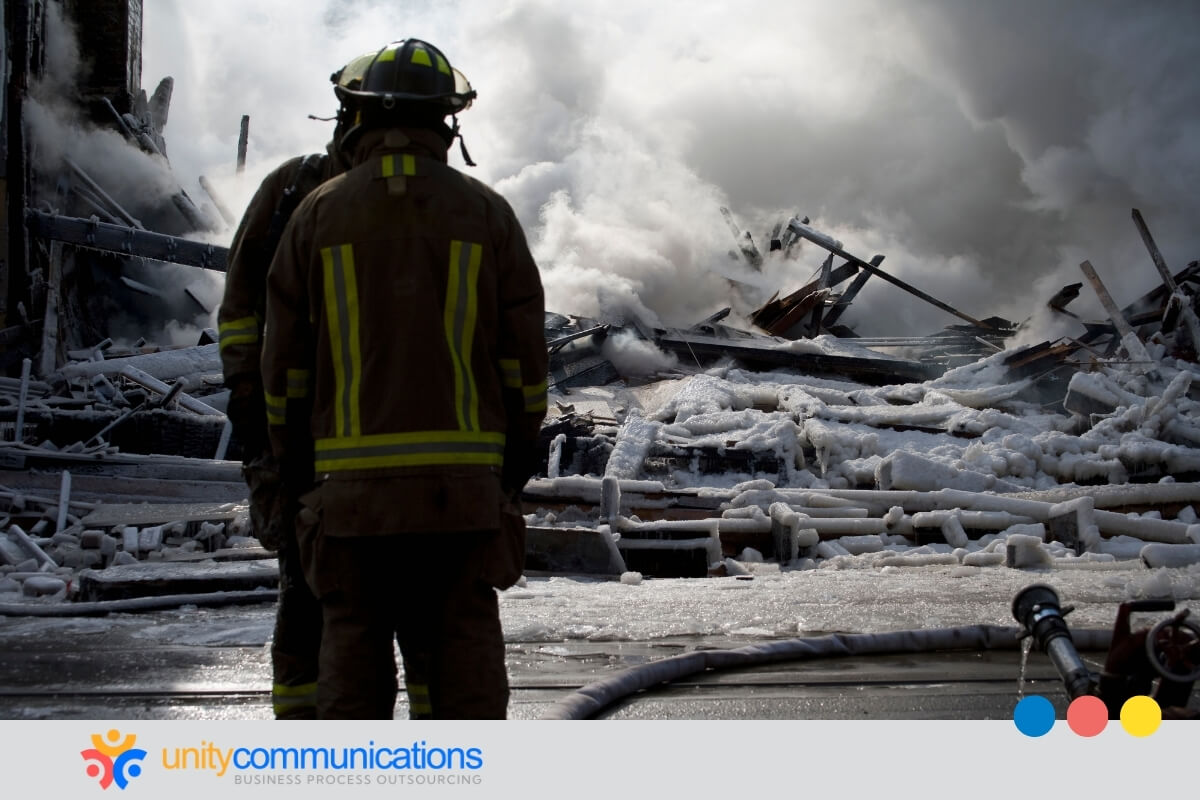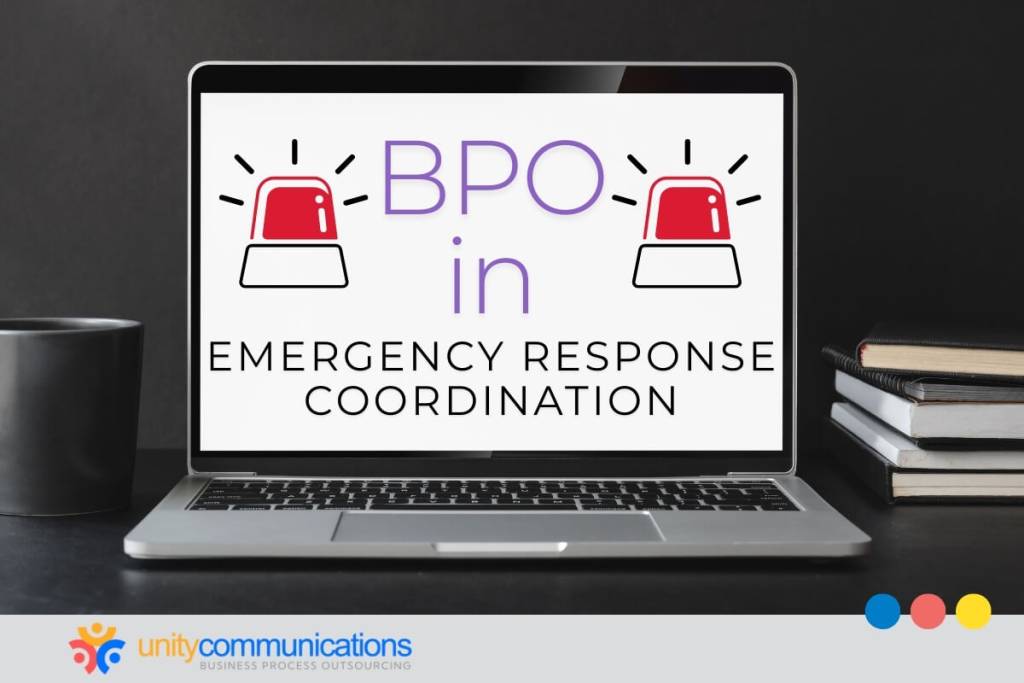Table of Contents
Timely and effective emergency response is critical to minimizing the impact of emergencies, whether dealing with natural disasters, public health crises, or security incidents. It can make all the difference in saving lives, protecting property, and restoring normalcy.
Emergency management professionals seek innovative ways to enhance coordination efforts in an era where data is increasingly driving decision-making. Integrating business process outsourcing (BPO) can transform how agencies predict, plan, and respond.
This article explores how BPO services can support emergency management and public safety sectors in elevating response coordination. Keep reading!
Importance of emergency response coordination
 Emergency management is essential to protecting communities and building resilience against disasters. In 2022, 387 global natural disasters were reported, resulting in 30,704 deaths and affecting 185 million people.
Emergency management is essential to protecting communities and building resilience against disasters. In 2022, 387 global natural disasters were reported, resulting in 30,704 deaths and affecting 185 million people.
As the frequency and severity of disasters and public health crises increase, proactiveness is critical for emergency management professionals, government agencies, and public safety organizations.
Effective coordination aligns all parties—whether first responders, medical teams, or government agencies—so they can act swiftly. This alignment is critical for saving lives, minimizing damage, and restoring stability quickly.
In high-stakes scenarios, rapid and effective response hinges on solid teamwork. Well-coordinated efforts streamline communication, prevent confusion, and reduce resource mismanagement. When everyone is aligned, organizations can minimize damage, protect vulnerable populations, and mitigate risks more efficiently.
BPO’s role in revolutionizing emergency response coordination

What is BPO, and how does it redefine emergency response coordination? Understanding the answers to these questions allows organizations to gauge the benefits BPO brings to their operations.
BPO is the practice of contracting third-party service providers to manage specific activities. It transforms emergency response coordination by streamlining processes and optimizing resources. By outsourcing tasks such as data processing and communication services, agencies can focus on critical decisions while benefiting from enhanced efficiency.
Take a closer look at how organizations can unlock the power of BPO in emergency response coordination:
Leveraging big data for predictive analytics
The explosion of big data in recent years has created new opportunities for organizations to leverage predictive analytics. Predictive analytics uses historical data to identify patterns and forecast outcomes, helping emergency response teams to plan well.
BPO providers support emergency management professionals by harnessing big data. They analyze information from various sources, such as weather patterns, crime statistics, and health records, to predict emergencies. For instance, predictive models can “foresee” natural disasters, enabling agencies to allocate resources more effectively.
Furthermore, big data and predictive analytics help organizations reduce operating costs. Emergency management professionals can avoid unnecessary expenses by accurately forecasting demand and resource needs. BPO further minimizes costs by eliminating the need to invest in forecasting expertise and technologies.
Optimizing operational efficiency through advanced data analytics
Operational efficiency is crucial in emergency response coordination, where time is of the essence. BPO firms leverage advanced data analytics to provide real-time insights, allowing organizations to streamline operations and make quick, informed decisions.
In fact, companies adopting data-driven decision-making have increased productivity rates by 63%, showcasing the effectiveness of analytics in boosting performance.
Data analytics in BPO enables agencies to analyze workflow patterns, identify bottlenecks, and make data-driven adjustments to improve processes. This is especially valuable for emergency response coordination, where even minor delays can have significant consequences.
Additionally, emergency response teams can use advanced analytics to continuously track key performance indicators (KPIs), such as response times and resource utilization rates. This ensures that organizations stay agile and responsive, adapting to real-time situations.
Enhancing customer experience by analyzing customer data
A seamless customer experience is critical in emergency management, mainly when dealing with high-stress situations. For efficiency and clarity, BPO services can enhance the experience by analyzing customer data and optimizing all touchpoints, from initial contact to final resolution.
BPO providers can mine customer data, such as previous interactions, preferences, and feedback, to better understand the needs of those they serve. Public safety agencies can tailor their services to improve communication and personalize support. Emergency call centers, for instance, can use data to prioritize high-risk cases and provide rapid response.
Tailoring services and products using analytics-driven insights
Tailoring services and products based on data-driven insights allows organizations to meet the unique needs of their communities. In BPO for emergency response coordination, advanced analytics can examine demographic data, usage patterns, and regional needs to customize services based on the location’s demands.
For example, predictive models can analyze historical data, weather patterns, and vegetation levels in a region prone to wildfires to inform resource allocation. These models can predict areas where fires are most likely to occur and determine the optimal locations to pre-position firefighting equipment and personnel before wildfire season begins.
Emergency management agencies can use the data to stockpile water, fire retardants, and evacuation supplies in the most vulnerable places for rapid response when a fire breaks out.
Moreover, BPO services can provide emergency management professionals with the flexibility to scale operations. By understanding peak seasons, agencies can adjust their staffing and resources accordingly, ensuring that they are always prepared to meet the demands of their communities.
Identifying trends and market opportunities with real-time data analysis
Real-time data analysis allows emergency management professionals to stay alert to emerging trends, potential crises, and market opportunities that could affect their operations. BPO providers obtain live data from multiple sources, such as weather monitoring systems, social media feeds, traffic sensors, and health reports, to generate critical insights for more proactive response plans.
Consider a coastal area vulnerable to hurricanes. Emergency management teams can monitor real-time data from weather satellites and local news to track storm progress. BPO providers might use data analytics tools to detect patterns, such as increased traffic congestion due to preemptive evacuations. Real-time social media analysis can reveal residents’ concerns or needs as they prepare.
Based on the information, the emergency response agency can pre-deploy supplies, adjust evacuation routes to avoid traffic bottlenecks, and communicate directly with at-risk populations for a more efficient, quicker response. BPO teams can also identify gaps in community awareness or areas needing additional support and adapt their services for better crisis resilience.
Streamlining decision-making with advanced analytics tools
Advanced analytics tools in BPO for emergency response coordination streamline decision-making processes by offering real-time access to critical information. Emergency management professionals can leverage these tools to evaluate multiple data points simultaneously, allowing them to make well-informed decisions under pressure.
For instance, advanced analytics can provide real-time updates on resource availability, weather conditions, and population density during a natural disaster to speed up resource deployment.
Furthermore, data-driven decision-making reduces human error, as agencies base decisions on objective data rather than intuition. By relying on analytics tools, emergency response teams can make more accurate assessments and deploy resources more effectively.
Improving risk management through predictive modeling
Effective risk management is essential for emergency response coordination. BPO providers using predictive modeling can help organizations anticipate risks and manage them before they escalate.
Predictive modeling analyzes historical data to identify patterns that signal risks, such as natural disasters or security threats. Emergency response teams can use this information to prepare contingency plans, allocate resources efficiently, and minimize the impact of emergencies on communities.
By integrating predictive modeling into their BPO strategies, organizations can also perform regular risk assessments to prepare for worst-case scenarios. This proactive approach strengthens their risk management capabilities and helps mitigate financial and operational threats.
Maximizing ROI by focusing efforts on data-driven strategies
Organizations can maximize their return on investment (ROI) by focusing BPO efforts on data-driven strategies.
Data-driven strategies enable emergency management professionals to allocate resources where they are most needed, reducing waste and ensuring optimal use of personnel and equipment. Additionally, real-time data analysis allows agencies to make cost-effective decisions that improve short-term and long-term outcomes.
Furthermore, by focusing on data-driven strategies, BPO providers can offer more targeted services that meet the specific needs of emergency management agencies, resulting in higher efficiency and lower operating costs.
Integrating AI and ML for more accurate data analysis
Artificial intelligence (AI) and machine learning (ML) are revolutionizing data analysis in BPO, offering more accurate insights than traditional methods.
AI and ML algorithms can analyze vast data in real time and identify patterns and trends that human analysts might miss. This means predicting and responding to emergencies more quickly for emergency response agencies.
With the global AI market projected to grow from $638.23 billion in 2024 to $3.680 trillion by 2034, AI and ML will continue to enhance the efficiency and effectiveness of BPO services in emergency response coordination.
The bottom line

As emergencies grow more frequent and complex, effective coordination is more critical than ever. BPO is reshaping emergency response coordination by streamlining operations and enhancing decision-making through AI and real-time data analytics. Teams can respond more quickly and accurately, saving lives and cutting costs.
Now is the time for organizations to embrace BPO-driven strategies to boost efficiency and stay ahead of crises. Let’s connect to explore how BPO can strengthen your emergency response efforts.




